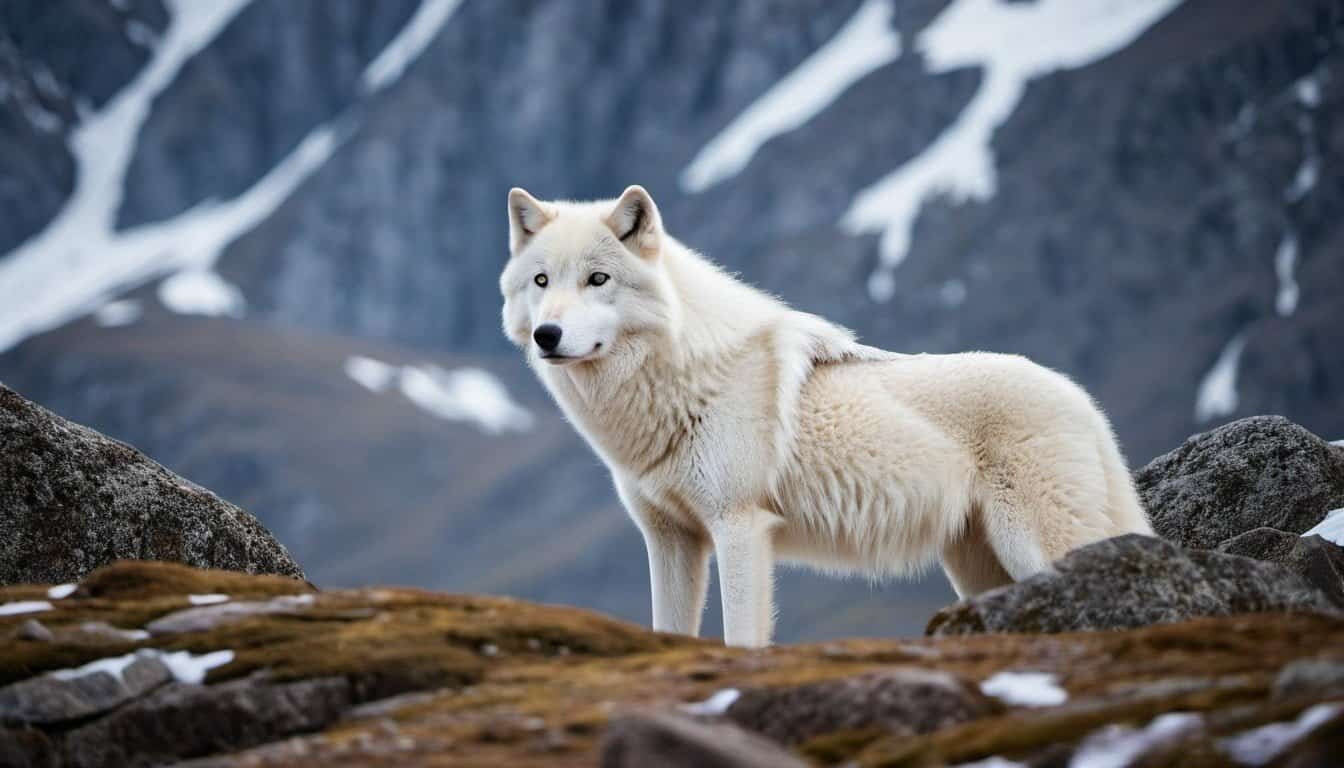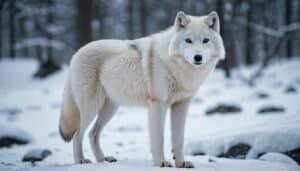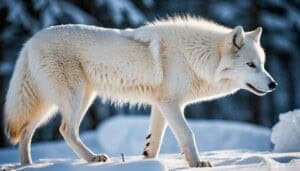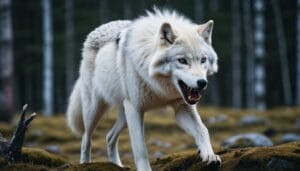Introduction
Arctic wolves have developed unique adaptations that enable them to endure the harsh conditions of their environment, particularly during periods of food scarcity
This article will explore the physiological and metabolic adaptations that allow these wolves to conserve energy, the behavioral strategies they employ to maximize their hunting success and cooperation within packs, and the impact of environmental changes on their survival
By understanding these aspects, we gain insight into the remarkable resilience of the Arctic wolf
Physiological and Metabolic Adaptations
Arctic wolves possess a range of physiological and metabolic adaptations that enable them to survive in extreme conditions, especially when food is scarce. These adaptations are crucial for conserving energy and maintaining body functions during long periods without adequate nutrition
Metabolic Adaptations
One of the most significant adaptations of Arctic wolves is their ability to lower their metabolic rate. By reducing their metabolic rate, these wolves can conserve energy, allowing them to survive longer periods without food. This metabolic flexibility is particularly useful during the harsh winter months when prey is scarce and hunting is more challenging
The Arctic wolf’s metabolism is fine-tuned to optimize energy usage. When food is abundant, they build up fat reserves, which can be utilized during lean periods. This ability to switch between a high metabolism during periods of abundance and a lower metabolism during scarcity is a key survival mechanism
Role of Fat Storage
Fat storage plays a crucial role in the survival of Arctic wolves. These wolves can accumulate significant fat reserves when food is plentiful, which they metabolize during periods of food scarcity. This fat not only provides energy but also acts as insulation against the extreme cold, helping to maintain body temperature and overall health
The distribution of fat in Arctic wolves is also strategically beneficial. Fat deposits around vital organs and under the skin ensure that the wolf can stay warm and protect its core functions even when external temperatures drop drastically. This dual role of fat as both an energy source and an insulator highlights its importance in the wolf’s survival strategy
Energy Conservation Mechanisms
In addition to metabolic adaptations and fat storage, Arctic wolves employ various energy conservation mechanisms. One such mechanism is reducing activity levels during times of food scarcity
By minimizing movement, they conserve energy and reduce the need for caloric intake. This behavior is often observed during the coldest months when the energy expenditure for hunting would outweigh the caloric gain from potential prey
Another energy conservation tactic is huddling with pack members. This behavior not only provides warmth through shared body heat but also fosters social bonds and cooperation, which are vital for the pack’s survival. By sticking together, wolves reduce individual energy expenditure and improve their chances of finding food collectively
Arctic wolves also exhibit a remarkable ability to enter a state of torpor, a form of temporary hibernation where their body temperature and metabolic rate drop significantly
This state allows them to endure extreme cold and lack of food for extended periods. Torpor is a critical adaptation that enables Arctic wolves to survive the harshest conditions of their environment
Behavioral and Survival Strategies
Arctic wolves employ a variety of behavioral strategies to cope with food scarcity and survive in their challenging environment. These strategies include advanced hunting techniques, cooperation within their packs, and adapting to seasonal prey availability
Hunting Techniques
Arctic wolves have developed sophisticated hunting techniques to maximize their chances of capturing prey in the harsh Arctic environment. They are highly skilled hunters, capable of taking down large animals such as musk oxen and caribou. Their hunting success relies on both individual prowess and pack coordination
One notable technique is the use of strategic ambushes. Arctic wolves often use the terrain to their advantage, stalking prey through the snow and launching surprise attacks
This method is particularly effective in the open tundra, where the element of surprise is crucial for overcoming the speed and agility of their prey
Another technique involves endurance hunting. Arctic wolves can travel long distances and maintain a steady pace, wearing down their prey over time. This persistence hunting approach is especially useful for capturing fleet-footed animals that can outrun a short sprint but tire over longer chases
Pack Behavior and Cooperation
The social structure of Arctic wolves plays a significant role in their survival. Living and hunting in packs allows them to tackle larger prey and improve their hunting efficiency. Pack cooperation is essential for both hunting success and overall survival, particularly during times of food scarcity
Pack behavior is characterized by a well-defined hierarchy, with a dominant alpha pair leading the group. This hierarchy ensures organized and coordinated efforts during hunts. Each member of the pack has specific roles, such as scouting, chasing, or cornering prey, which enhances their collective hunting success
Additionally, the pack provides social support, which is crucial for survival in the harsh Arctic environment. Wolves share food with pack members, ensuring that even the weaker or younger individuals receive nourishment
This social bond and cooperative behavior increase the overall resilience of the pack, allowing them to endure periods of food scarcity more effectively
Seasonal Prey Availability
Arctic wolves must adapt to the seasonal availability of prey to survive. The Arctic tundra experiences significant fluctuations in prey populations due to migration patterns and breeding cycles. Understanding and adapting to these patterns is crucial for the wolves’ survival
During the summer months, prey such as caribou and musk oxen are more abundant, providing ample hunting opportunities. Arctic wolves take advantage of this period to build up their fat reserves and ensure the survival of their pups. The abundance of prey allows the pack to hunt more frequently and sustain themselves through the leaner winter months
In contrast, winter poses a greater challenge due to the scarcity of prey. Many animals migrate or hibernate, leaving fewer hunting options for the wolves. During this time, Arctic wolves rely on their stored fat reserves and reduce their activity levels to conserve energy. They may also target smaller prey, such as hares or rodents, to supplement their diet
The ability to adapt to these seasonal changes in prey availability is a critical survival strategy for Arctic wolves. Their flexible hunting techniques, cooperative pack behavior, and understanding of prey migration patterns enable them to endure the harsh conditions of their environment
Environmental Impact on Survival
Arctic wolves face numerous environmental challenges that impact their survival. These include climate change, changes in prey populations, and habitat alterations
Understanding how these factors affect Arctic wolves helps to highlight their resilience and adaptability in a rapidly changing world
Impact of Climate Change
Climate change is one of the most significant environmental challenges impacting Arctic wolves. Rising temperatures and shifting weather patterns alter the Arctic landscape, affecting the availability of prey and the wolves’ ability to hunt
One of the primary impacts of climate change is the loss of sea ice. As sea ice diminishes, so does the habitat for many of the Arctic wolf’s prey species, such as seals and polar bears. This reduction in prey availability forces wolves to travel greater distances in search of food, expending more energy and increasing the risk of starvation
Additionally, warmer temperatures can lead to changes in the behavior and migration patterns of prey animals. For example, caribou may alter their migratory routes or timing, making it harder for wolves to predict and intercept them. These changes disrupt the delicate balance of the Arctic ecosystem and pose significant challenges to the survival of Arctic wolves
Changes in Prey Populations
Fluctuations in prey populations have a direct impact on the survival of Arctic wolves. The abundance and distribution of prey species, such as caribou, musk oxen, and Arctic hares, are crucial for the wolves’ sustenance
Overhunting and human activities can lead to a decline in prey populations, reducing the food sources available to Arctic wolves. In some areas, overgrazing by increasing herbivore populations, like caribou, can lead to habitat degradation, affecting the availability of food for both the prey and the wolves
Moreover, diseases and parasites can also influence prey populations. Outbreaks of disease among caribou or other prey species can lead to significant declines in their numbers, subsequently affecting the wolves that rely on them for survival
Arctic wolves must continuously adapt to these changes, shifting their hunting strategies and target species to ensure their survival
Adaptation to Habitat Alterations
Arctic wolves are highly adaptable animals, capable of surviving in a variety of habitats within the Arctic region. However, habitat alterations due to human activities and climate change pose significant challenges
Human activities such as mining, oil exploration, and infrastructure development can disrupt the natural habitats of Arctic wolves. These activities lead to habitat fragmentation, reducing the available hunting grounds and forcing wolves to navigate human-altered landscapes. This can increase the risk of human-wolf conflicts and reduce the wolves’ ability to find sufficient food
Despite these challenges, Arctic wolves demonstrate remarkable adaptability. They can adjust their hunting ranges, alter their dietary preferences, and modify their behavior to cope with habitat changes. For example, in areas where traditional prey is scarce, Arctic wolves may turn to alternative food sources such as birds, fish, or even human-provided waste
Their ability to adapt to changing environments underscores the resilience of Arctic wolves. However, continued habitat alterations and the pressures of climate change require ongoing adaptation and resilience for these wolves to thrive in the future
Conclusion
Arctic wolves have developed an array of remarkable adaptations that enable them to endure the extreme conditions of the Arctic and survive long periods without food. Their physiological and metabolic adaptations, including a flexible metabolism and efficient fat storage, allow them to conserve energy and withstand food scarcity
Behavioral strategies such as sophisticated hunting techniques, cooperative pack behavior, and seasonal adjustments further enhance their survival capabilities. Additionally, their ability to adapt to environmental challenges, including climate change and habitat alterations, showcases their resilience
However, the ongoing impact of climate change and human activities poses significant threats to their survival. Understanding and mitigating these threats are crucial for preserving the Arctic wolf’s future. By appreciating the intricate adaptations and behaviors of Arctic wolves, we can better appreciate the resilience of these magnificent creatures and the delicate balance of the Arctic ecosystem










